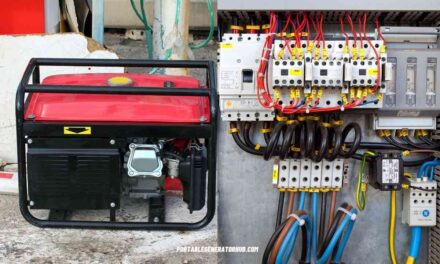
A portable generator can make life a lot more comfortable at a campsite or at home during a power outage. You can use it to power your AC during the muggy summer nights, while maybe you have some soothing music playing.
Portable generators have become the order of the day as they have more than enough features that could meet diverse reasons. Portable generators could be used for tailgating, camping, hiking, climbing, and many others.
It has the fundamental features you’d need, even in severe weather. Portable generators are now handier and possess notable features such as flashlights, USB ports, DC and AC power outlets to power all the pieces of equipment that you’ve got with you to power.
Nonetheless, there is a necessity to abate the noise of your generator if you ever find it emitting a sound that’s so unpleasing. Indeed, anything could prompt the need for abasing the sound. So, if you’ve ever got a need for quieting your portable generator, then check out the points stated below:
How to Quiet a Portable Generator – 8 Steps to Consider
1. Build a Soundproof Generator Box
A soundproof generator box has been a traditional way of reducing noises and reverberations that portable generators reproduce. Some get it right, and some don’t.
Nevertheless, you can check out the tips needed when building a DIYer soundproof. The fundamental tip to look out for when abating a generator’s noises would help reduce the noise by 15db and 20db.
- Build acoustic caulk at the sides to ensure that noise is conserved within the enclosure.
- Ensure that there is an available space that ensures carbon monoxide flares off easily.
- The soundproof should possess a roof and ceiling to minimize the noise emanating from the generator.
- Building a soundproof with heavy metal would only augment the noise. Use furniture or well-welder metal with acoustic caulk on the sides.
- Inquire from a professional to provide you with the real update.
2. Proper Placement of the Generator
Users are fond of using a portable generator on concrete and sloppy surfaces, probably to extend the running time as the fuel is more concentrated on the pipe to the carburetor.
This act could cause resonance as the vibration continually communicates with the concrete floor. However, buying a sound-absorbing mat would go a long way in preventing these that iterate sound reproduction. An absorbing mat is ample thick, and it could avoid noise emission at a high rate. Nevertheless, proper placement has to be implemented to get the whole act lucid and distinct.
3. Prioritize Repairing and Servicing the Generator
Loose bolts and nuts could improve the noise also. If a generator has never been constituting a nuisance before but abruptly began to do so, then you’re to check the loose bolts and nuts on the unit. Find out the parts sagging on the generator. It could be the tank, the exhaust, or the control panel. Heavy-duty generators are vulnerable to this. Check the amount of noise that a generator will reproduce before you in the first place.
4. Get a Quiet Generator
This may seem obvious, but it has to be said in case you overlook this factor. You don’t need to learn how to quiet a portable generator if it’s already quiet enough for you.
That’s why you need to take the noise into account when you buy your portable generator. Do remember that bigger generators with more watts to offer to tend to be noisier as well.
Some portable gasoline generators are quieter than others even with the same wattage. That’s because they have more effective mufflers or they have noise-suppressing technology like Idle Control.
If your watt requirements aren’t all that high, you may instead go with a power station that’s basically a hand-carried rechargeable battery. This can be enough to recharge smartphones and laptops at camp. These power stations don’t make any noise at all.
5. Keep the Generator Away from You
You should be old enough to know by now that a noisy object is noisier if it’s right beside you. That’s why if you want to spare your eardrums, keep the generator far away.
Keep in mind that when a manufacturer discloses the decibels produced by their generators, they’re measured from 23 feet away.
6. Use Rubber Waffle Pads
The vibrations the generator produces contribute to the noise levels, so you need to keep the vibrations down. One simple way to do this is to place rubber waffle pads on the ground before you put in the generator.
7. Dampen the Engine Block Noise
The stock screws on the engine block generally have rubber gaskets to minimize the noise. You can improve on that by adding an extra rubber washer along with longer bolts.
8. Enclose the Generator
You do know that when your audio speaker is on the other side of a wall, it doesn’t sound as loud. So you can expand on that principle and build walls along all the sides of the generator to create an enclosure.
The only side where there shouldn’t be any wall is the side with the switches and outlets. You can just use cinder blocks for your wall, as you don’t have to seal them. Just stack them until the stack is about a foot higher than the generator.
Make sure you have some breathing space between the walls and the generator too. This breathing space should be about 6 to 12 inches.
You can then test this by turning the generator on and you can check if the noise levels are tolerable enough for you. If it’s a bit too noisy, use more insulation for the cinder block walls.
Can You Put a Silencer on a Generator?
Yes, it’s possible, especially on generators that use fuel. Buy the silencer that suits the exhaust of your generator the most so that you can have an effective result. All you’ve to do is connect the silencer to your generator’s exhaust. Properly fixing this could reduce noises emanating from your generator by the rate of 12db and 18db; what matters is the effectiveness of your fixation.
Can You Put a Quieter Muffler on My Generator?
This is known as the silencer also. You’re to do proper scrutiny before buying a product if your unit doesn’t come with one. Identify the features that come with the quieter muffler and follow the direction in the manual booklet to implement the coupling.
How Do You Build a Sound Barrier for a Generator?
- Get the medium fiberboard needed and cut the board into respective sizes as the size of the generator.
- You’d need an acoustic caulk and insulating leather cover. Cut into a shed-view design. In other words, some will be designated for horizontal, and some will be for vertical alignment.
- Nail those designed for the vertical to the horizontal. Do this for the three sides that include the ambiance and the back.
- Merge the three to make them stand upright. Fix the acoustic caulk in the spaces and use your fingertips to reinforce them into the spaces.
- Use the insulating leather cover to seal the exterior. People won’t see the meshed nailed fiberboard but the waterproof, insulating leather cover.
- You can use a trampoline to shield the top by nailing it on its top. Removing the sound barrier is as simple as lifting from the ground and returning it to its spot to cover the generator.
Final Tip
Perhaps you can use earbuds when you sleep!





